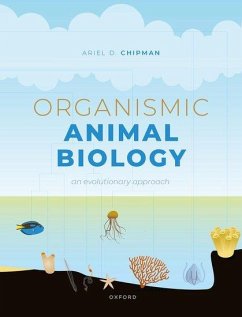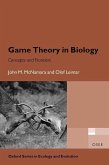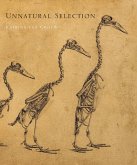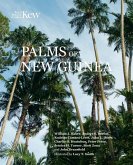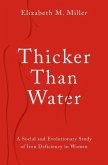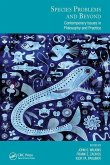Ariel D. Chipman (Professor Professor and Depa Departmental Chair
Organismic Animal Biology
An Evolutionary Approach
Ariel D. Chipman (Professor Professor and Depa Departmental Chair
Organismic Animal Biology
An Evolutionary Approach
- Broschiertes Buch
- Merkliste
- Auf die Merkliste
- Bewerten Bewerten
- Teilen
- Produkt teilen
- Produkterinnerung
- Produkterinnerung
This accessible textbook provides a basic understanding of the general evolutionary principles of organismic animal biology and animal diversity. It integrates parallel themes of body organization and phylogeny to provide an evolutionary journey through the diversity of animal life.
Andere Kunden interessierten sich auch für
![GAME THEORY IN BIOLOGY OSEE P GAME THEORY IN BIOLOGY OSEE P]() John M. McNamara (School of Mathematics, University of Bristol, UK)GAME THEORY IN BIOLOGY OSEE P60,99 €
John M. McNamara (School of Mathematics, University of Bristol, UK)GAME THEORY IN BIOLOGY OSEE P60,99 €![The Biology of Death The Biology of Death]() Gary C. Howard (Former Science Editor, Former Science Editor, GladsThe Biology of Death44,99 €
Gary C. Howard (Former Science Editor, Former Science Editor, GladsThe Biology of Death44,99 €![Unnatural Selection Unnatural Selection]() Katrina van GrouwUnnatural Selection53,99 €
Katrina van GrouwUnnatural Selection53,99 €![Palms of New Guinea Palms of New Guinea]() Palms of New Guinea80,99 €
Palms of New Guinea80,99 €![Natural Kinds Natural Kinds]() Muhammad Ali Khalidi (City University of New York)Natural Kinds22,99 €
Muhammad Ali Khalidi (City University of New York)Natural Kinds22,99 €![Thicker Than Water Thicker Than Water]() Elizabeth M. Miller (Associate Associate Professor of AnthropologyThicker Than Water28,99 €
Elizabeth M. Miller (Associate Associate Professor of AnthropologyThicker Than Water28,99 €![Species Problems and Beyond Species Problems and Beyond]() Species Problems and Beyond57,99 €
Species Problems and Beyond57,99 €-
-
-
This accessible textbook provides a basic understanding of the general evolutionary principles of organismic animal biology and animal diversity. It integrates parallel themes of body organization and phylogeny to provide an evolutionary journey through the diversity of animal life.
Produktdetails
- Produktdetails
- Verlag: Oxford University Press
- Seitenzahl: 240
- Erscheinungstermin: 12. März 2024
- Englisch
- Abmessung: 247mm x 188mm x 22mm
- Gewicht: 522g
- ISBN-13: 9780192893598
- ISBN-10: 0192893599
- Artikelnr.: 68430336
- Herstellerkennzeichnung
- Libri GmbH
- Europaallee 1
- 36244 Bad Hersfeld
- gpsr@libri.de
- Verlag: Oxford University Press
- Seitenzahl: 240
- Erscheinungstermin: 12. März 2024
- Englisch
- Abmessung: 247mm x 188mm x 22mm
- Gewicht: 522g
- ISBN-13: 9780192893598
- ISBN-10: 0192893599
- Artikelnr.: 68430336
- Herstellerkennzeichnung
- Libri GmbH
- Europaallee 1
- 36244 Bad Hersfeld
- gpsr@libri.de
Ariel D. Chipman is an evolutionary developmental biologist at The Hebrew University of Jerusalem. He is currently Professor and Chair of the Department of Ecology, Evolution & Behavior, and the academic curator of invertebrates at the National Natural History Collections. His research focuses on the evolution of the arthropod body plan. He is the author of over 40 peer reviewed articles and book chapters and is the editor of Cellular Processes in Segmentation (CRC Press, 2020). His teaching experience includes a first year undergraduate course on organismic biology, which he has been teaching for over 15 years, as well as advanced courses in evo-devo, animal evolution, and systematics.
Preface
1: The Hierarchical Nature of Biology
2: Species Concepts and Speciation
3: What Is an Organism? The Simplest Organisms
4: The Concept of Evolutionary Change
5: Multicellularity
6: Sponges: The Simplest Multicellular Organisms
7: Germ Layers: Inside and Outside
8: Motility and Symmetry
9: Diploblastic Organisms: Cnidaria and Ctenophora
10: Colonial Organisms and Complex Life Cycles
11: Bilateria
12: Sensory Systems
13: Platyhelminthes
14: Parasitism
15: Mollusca
16: Coeloms and Skeletons
17: Annelida
18: Segmental Organization of the Body
19: Size and Complexity
20: Molting Animals
21: Arthropoda I: General Introduction and Chelicerata
22: Terrestrialization
23: Arthropoda II: Mandibulata
24: Transport and Gas Exchange Systems
25: Embryogenesis
26: Echinodermata
27: Chordata and Hemichordata
28: Excretory Systems
29: Vertebrate Characteristics
30: Vertebrate Diversity
31: Vertebrate Organogenesis
32: Organismic Biology in the Twenty-First Century
1: The Hierarchical Nature of Biology
2: Species Concepts and Speciation
3: What Is an Organism? The Simplest Organisms
4: The Concept of Evolutionary Change
5: Multicellularity
6: Sponges: The Simplest Multicellular Organisms
7: Germ Layers: Inside and Outside
8: Motility and Symmetry
9: Diploblastic Organisms: Cnidaria and Ctenophora
10: Colonial Organisms and Complex Life Cycles
11: Bilateria
12: Sensory Systems
13: Platyhelminthes
14: Parasitism
15: Mollusca
16: Coeloms and Skeletons
17: Annelida
18: Segmental Organization of the Body
19: Size and Complexity
20: Molting Animals
21: Arthropoda I: General Introduction and Chelicerata
22: Terrestrialization
23: Arthropoda II: Mandibulata
24: Transport and Gas Exchange Systems
25: Embryogenesis
26: Echinodermata
27: Chordata and Hemichordata
28: Excretory Systems
29: Vertebrate Characteristics
30: Vertebrate Diversity
31: Vertebrate Organogenesis
32: Organismic Biology in the Twenty-First Century
Preface
1: The Hierarchical Nature of Biology
2: Species Concepts and Speciation
3: What Is an Organism? The Simplest Organisms
4: The Concept of Evolutionary Change
5: Multicellularity
6: Sponges: The Simplest Multicellular Organisms
7: Germ Layers: Inside and Outside
8: Motility and Symmetry
9: Diploblastic Organisms: Cnidaria and Ctenophora
10: Colonial Organisms and Complex Life Cycles
11: Bilateria
12: Sensory Systems
13: Platyhelminthes
14: Parasitism
15: Mollusca
16: Coeloms and Skeletons
17: Annelida
18: Segmental Organization of the Body
19: Size and Complexity
20: Molting Animals
21: Arthropoda I: General Introduction and Chelicerata
22: Terrestrialization
23: Arthropoda II: Mandibulata
24: Transport and Gas Exchange Systems
25: Embryogenesis
26: Echinodermata
27: Chordata and Hemichordata
28: Excretory Systems
29: Vertebrate Characteristics
30: Vertebrate Diversity
31: Vertebrate Organogenesis
32: Organismic Biology in the Twenty-First Century
1: The Hierarchical Nature of Biology
2: Species Concepts and Speciation
3: What Is an Organism? The Simplest Organisms
4: The Concept of Evolutionary Change
5: Multicellularity
6: Sponges: The Simplest Multicellular Organisms
7: Germ Layers: Inside and Outside
8: Motility and Symmetry
9: Diploblastic Organisms: Cnidaria and Ctenophora
10: Colonial Organisms and Complex Life Cycles
11: Bilateria
12: Sensory Systems
13: Platyhelminthes
14: Parasitism
15: Mollusca
16: Coeloms and Skeletons
17: Annelida
18: Segmental Organization of the Body
19: Size and Complexity
20: Molting Animals
21: Arthropoda I: General Introduction and Chelicerata
22: Terrestrialization
23: Arthropoda II: Mandibulata
24: Transport and Gas Exchange Systems
25: Embryogenesis
26: Echinodermata
27: Chordata and Hemichordata
28: Excretory Systems
29: Vertebrate Characteristics
30: Vertebrate Diversity
31: Vertebrate Organogenesis
32: Organismic Biology in the Twenty-First Century

